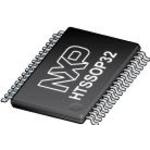




CAN 20Kbps Normal/Standby Automotive 32Pin HTSSOP EP T/R
Overview
The UJA1078A core System Basis Chip SBC replaces the basic discrete components commonly found in Electronic Control Units ECU with a high-speed Controller Area Network CAN and two Local Interconnect Network LIN interfaces.
The UJA1078A supports the networking applications used to control power and sensor peripherals by using a high-speed CAN as the main network interface and the LIN interfaces as local sub-busses.
The core SBC contains the following integrated devices:
* High-speed CAN transceiver, inter-operable and downward compatible with CAN transceiver TJA1042, and compatible with the ISO 11898-2 and ISO 11898-5 standards
* LIN transceivers compliant with LIN 2.1, LIN 2.0 and SAE J2602, and compatible with LIN 1.3
* Advanced independent watchdog UJA1078A/xx/WD versions
* 250 mA voltage regulator for supplying a microcontroller; extendable with external PNP transistor for increased current capability and dissipation distribution
* Separate voltage regulator for supplying the on-board CAN transceiver
* Serial Peripheral Interface SPI full duplex
* 2 local wake-up input ports
* Limp home output port
In addition to the advantages gained from integrating these common ECU functions in a single package, the core SBC offers an intelligent combination of system-specific functions such as:
* Advanced low-power concept
* Safe and controlled system start-up behavior
* Detailed status reporting on system and sub-system levels
The UJA1078A is designed to be used in combination with a microcontroller that incorporates a CAN controller. The SBC ensures that the microcontroller always starts up in a controlled manner.
MoreLess
## Features
**2.1 General**
* Contains a full set of CAN and LIN ECU functions:
* CAN transceiver and two LIN transceivers
* Scalable 3.3 V or 5 V voltage regulator delivering up to 250 mA for a microcontroller and peripheral circuitry; an external PNP transistor can be connected for better heat distribution over the PCB
* Separate voltage regulator for the CAN transceiver 5 V
* Watchdog with Window and Timeout modes and on-chip oscillator
* Serial Peripheral Interface SPI for communicating with the microcontroller
* ECU power management system
* Designed for automotive applications:
* Enhanced ElectroMagnetic Compatibility EMC performance
* ±8 kV ElectroStatic Discharge ESD protection Human Body Model HBM on the CAN/LIN bus pins and the wake-up pins
* ±6 kV ElectroStatic Discharge protection IEC 61000-4-2 on the CAN/LIN bus pins and the wake-up pins
* ±58 V short-circuit proof CAN/LIN bus pins
* Battery and CAN/LIN bus pins are protected against transients in accordance with ISO 7637-3
* Supports remote flash programming via the CAN bus
* Small 6.1 mm × 11 mm HTSSOP32 package with low thermal resistance
* Pb-free; Restriction of Hazardous Substances Directive RoHS and dark green compliant
**CAN transceiver**
* ISO 11898-2 and ISO 11898-5 compliant high-speed CAN transceiver
* Dedicated low dropout voltage regulator for the CAN bus:
* Independent of the microcontroller supply
* Significantly improves EMC performance
* Bus connections are truly floating when power is off
* SPLIT output pin for stabilizing the recessive bus level
**LIN transceivers**
* 2 × LIN 2.1 compliant LIN transceivers
* Compliant with SAE J2602
* Downward compatible with LIN 2.0 and LIN 1.3
* Low slope mode for optimized EMC performance
* Integrated LIN termination diode at pin DLIN
**Power management**
* Wake-up via CAN, LIN or local wake-up pins with wake-up source detection
* 2 wake-up pins:
* WAKE1 and WAKE2 inputs can be switched off to reduce current flow
* Output signal WBIAS to bias the wake-up pins, selectable sampling time of 16 ms or 64 ms
* Standby mode with very low standby current and full wake-up capability; V1 active to maintain supply to the microcontroller
* Sleep mode with very low sleep current and full wake-up capability
**Control and diagnostic features**
* Safe and predictable behavior under all conditions
* Programmable watchdog with independent clock source:
* Window, Timeout with optional cyclic wake-up and Off modes supported with automatic re-enable in the event of an interrupt
* 16-bit Serial Peripheral Interface SPI for configuration, control and diagnosis
* Global enable output for controlling safety-critical hardware
* Limp home output LIMP for activating application-specific ‘limp home’ hardware in the event of a serious system malfunction
* Overtemperature shutdown
* Interrupt output pin; interrupts can be individually configured to signal V1/V2 undervoltage, CAN/LIN/local wake-up and cyclic and power-on interrupt events
* Bidirectional reset pin with variable power-on reset length to support a variety of microcontrollers
* Software-initiated system reset
**Voltage regulators**
* Main voltage regulator V1:
* Scalable voltage regulator for the microcontroller, its peripherals and additional external transceivers
* ±2 % accuracy
* 3.3 V and 5 V versions available
* Delivers up to 250 mA and can be combined with an external PNP transistor for better heat distribution over the PCB
* Selectable current threshold at which the external PNP transistor starts to deliver current
* Undervoltage warning at 90 % of nominal output voltage and undervoltage reset at 90 % or 70 % of nominal output voltage
* Can operate at VBAT voltages down to 4.5 V e.g. during cranking, in accordance with ISO 7637 pulse 4/4b and ISO16750-2
* Stable output under all conditions
* Voltage regulator V2 for CAN transceiver:
* Dedicated voltage regulator for on-chip high-speed CAN transceiver
* Undervoltage warning at 90 % of nominal output voltage
* Can be switched off; CAN transceiver can be supplied by V1 or by an external voltage regulator
* Can operate at VBAT voltages down to 5.5 V e.g. during cranking in accordance with ISO 7637, pulse 4
## Features